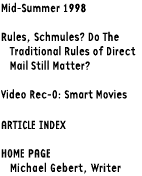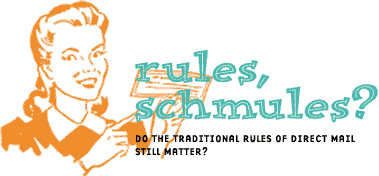


THE DIRECT MAIL BIZ PRIDES ITSELF on its time-tested creative “rules”—the idea that if your Johnson Box is in the right place and so on, you’re practically guaranteed a 2% response.
These rules were worked out in the 30’s, 40’s and 50’s by men like John Caples and Les Wunderman, selling things like magazines and book clubs. However, I think it’s time to question how well the learning those pioneers gained really applies to the entire field today, particularly if you’re working under any of the following conditions:
1. You’re not selling a magazine or a book club.
2. It isn’t the 30’s, 40’s, or 50’s.
A 1950s housewife got one piece of direct mail that week. Her 1990s counterpart gets ten pieces of mail (and four AOL disks) a day. She fast-forwards through Nike :30s. What are the odds she’s going to read a four-page letter?
In fact, she’s gotten quite good at extracting the information she really needs and discarding the rest. She can strip the introductory APR and annual fee from a credit card mailing like a school of piranhas cleaning a carcass.
She’s not impressed by a “handwritten” note from the president of the company, or even a Post-It signed “J.” And she notices when a well-known brand name suddenly stoops to cheap tricks. (Or at least I do. I once got a subscription solicitation for Smithsonian, no doubt sold to them on its effectiveness for Gun Nut or Motel Towel Collector, that was so cheesy and deceptive that it’s clouded their reputation for me ever since. Besides which, I’m still waitin’ for my FREE TV!)
Rules for a creative endeavor? If the century of Picasso, Stravinsky and Monty Python has taught us anything, it’s that there aren’t any. Only tactics, which may work brilliantly for a while... but start to lose their effectiveness around the time that everyone around you starts to use them.
Then, like Pablo, Igor or Les before you, you have to stumble around on virgin territory until you find something new of your own. Here are some—not rules, but principles I try to keep in mind, to help me find my way to someplace new. Where everybody else isn’t already living... by the rules.

1. There’s a straight line from the mailbox to the trash, and your only hope is to break it. A direct vet once told me, “You seem a lot more interested in the concept than the copy.” I was about to thank him when I realized it was a criticism. “But the body copy’s where the sale is made,” he admonished me. Not when it’s in an unopened envelope in a landfill it isn’t. An arresting outer concept is everything.
2. People throw away more white #10 envelopes than anything else on Earth. Any other format, size or color is at least worth a try.
3. If you don’t have a lot to say, send less paper. Instead of belaboring it in a letter, say it once in a memorable way on a postcard or roll-fold mailer.
4. If it seems too tacky for your brand to put it in a TV commercial, don’t mail it. You can spend a ton on image TV, but if you flood the world with blatant deceptions or bribes to switch to you, then that’s your image, not the fancy TV spots.
And finally:
5. I try to remember that an unexpected letter in the mail is supposed to be one of life’s little pleasures.
Go to Video Rec-O
POSTSCRIPT: So you're Mr. Old Style Direct Guy, and you read this and you say Sure, buddy, you can make pretty pieces for your portfolio with these fancy-schmancy rules of yours, but can you make the cash register ring? Well, a couple of months after this issue came out I got a perfect test case assignment: US WEST had a wireless phone promotion aimed at the Christmas season, and desperately didn't want it to got lost among the 5 zillion other wireless promotions they and all their competitors were running during that crazy time. So here's what I did--and how it did.
